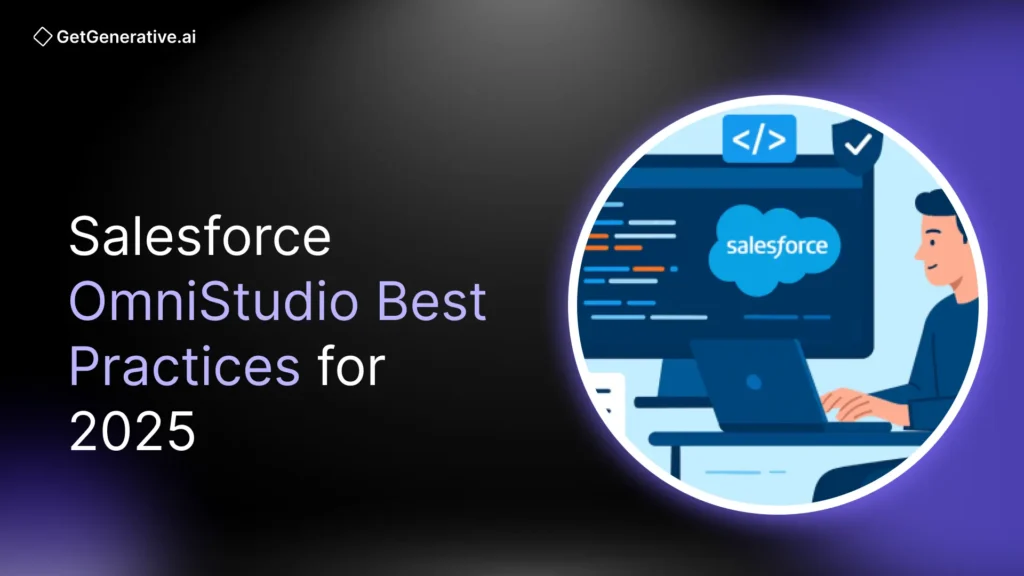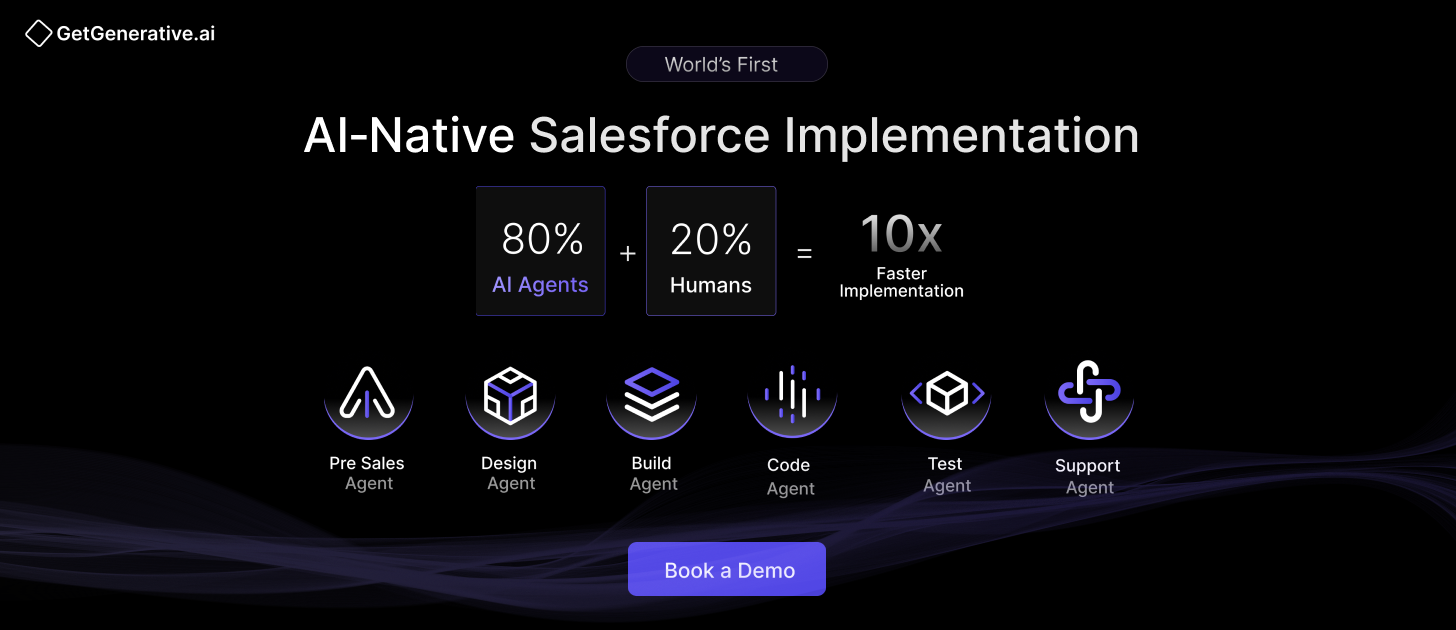Salesforce OmniStudio Best Practices for 2025
In 2025, the convergence of artificial intelligence, automation, and industry-specific accelerators makes OmniStudio adoption a strategic imperative. Companies that have embraced OmniStudio report 70% faster development cycles and 90% success rates in deployment when following structured best practices.
This guide offers actionable recommendations and strategic insights for you to maximize OmniStudio’s potential while minimizing risks.
Strategic Architecture and Component Design Excellence
Foundation-Level Design Principles
Successful OmniStudio implementations begin with strong architectural foundations. The most effective deployments embrace modular, component-based design that ensures scalability, maintainability, and optimized performance.
OmniStudio’s architecture is built on four key pillars:
- FlexCards – Dynamic, responsive UI components capable of rendering complex datasets with conditional logic and real-time data binding. Organizations report up to 75% faster development time for sophisticated interfaces using FlexCards.
- OmniScripts – Guided, multi-step processes that orchestrate data collection and user interactions with advanced branching logic. They adapt in real time to user input and business rules.
- DataRaptors – High-performance tools for transforming and loading data across Salesforce and external systems. Best practice limits DataRaptors to three or fewer SObjects, with all filters applied to indexed fields for speed.
- Integration Procedures – Server-side orchestration tools that streamline business logic execution and system integrations. Compared to traditional Apex, they deliver 35–45% higher productivity for developers.
Advanced Component Integration Patterns
Integration excellence is a hallmark of enterprise OmniStudio architecture. Instead of creating tightly coupled solutions, leading implementations adopt a service-oriented approach:
- Integration Procedures act as reusable business services.
- DataRaptors serve as dedicated data access layers.
- FlexCards provide composable UI building blocks.
Best practices include:
- Designing modular Integration Procedures that serve a single, well-defined purpose, enabling scalability and easier troubleshooting.
- Using try-catch error handling inside Integration Procedures instead of custom Apex code to reduce maintenance overhead.
- Implementing Response Actions to trim unnecessary data, which can cut payload sizes by 25–35%, boosting user experience.
- Adopting nested FlexCards for complex data hierarchies, ensuring design consistency across multiple use cases, particularly in regulated industries like healthcare or finance.
Performance Optimization and Scalability Excellence
Server-Side Performance Architecture
Performance and scalability are critical in enterprise-grade OmniStudio deployments.
- The Enhanced Runtime Performance setting introduced in 2025 allows OmniStudio components to interact directly with the Salesforce Platform instead of relying on Apex calls—delivering significant speed boosts for large-scale projects.
- Asynchronous execution patterns (Fire and Forget or Non-Blocking modes) improve responsiveness, cutting round-trip latency by 30–50%.
- Caching strategies—using Org Cache and Session Cache—reduce query times by 40–60%, though proper invalidation processes must be in place to avoid data integrity issues.
Client-Side Optimization Techniques
On the client side, efficiency comes from lean design and careful data handling:
- Keep OmniScripts within 750 elements or fewer for optimal loading across devices and networks.
- Manage PDF generation carefully, as files larger than 1 MB can cause delays or timeouts.
- Use Turbo Extract DataRaptors, which outperform traditional DataRaptors by 14–30% for single-object queries with indexed fields.
- For complex multi-object integrations, stick with traditional DataRaptors to avoid performance degradation.
- Ensure FlexCards pull data primarily from Integration Procedures, leveraging server-side power and caching for improved rendering times.
Also Read – Salesforce OmniStudio Use Cases
Enterprise Deployment and DevOps Excellence
Multi-Environment Pipeline Architecture
To scale OmniStudio enterprise-wide, robust DevOps pipelines are essential.
- Structured deployments enable 75% faster release cycles and reduce errors.
- The OmniStudio Build Tool automates dependency resolution, shrinking deployment time from hours to minutes while ensuring traceability.
- Integration with Git workflows supports parallel development and precise version control.
- Automated pipelines tied into Jenkins, GitLab CI/CD, or Azure DevOps streamline testing and deployment for FlexCards, OmniScripts, DataRaptors, and Integration Procedures. Initial setup may require 40–60 hours, but the long-term efficiency gains are significant.
- Rollback protocols are a must, with mature organizations ensuring they can restore full functionality within 2–4 hours if an issue arises.
Migration Strategy Framework
The shift from OmniStudio Managed Packages to Standard Runtime is a pivotal 2025 initiative.
Key best practices for migration include:
- Three-phase execution – sandbox conversion, sandbox validation, and phased production rollout.
- Comprehensive inventory and compatibility checks – ensuring features and industry-cloud dependencies remain supported.
- Strict adherence to naming conventions – the migration tool requires compliance, which may necessitate refactoring.
- Leverage the OmniStudio Migration Tool for automated metadata transfer, minimizing manual errors.
- Validate not just components but real business workflows, followed by rigorous load testing in production-like conditions.
Security, Governance, and Compliance Framework
Enterprise Security Architecture
Security remains one of the most critical considerations for OmniStudio deployments. A robust framework addresses both component-level access and data-level governance:
- Profile-based access controls determine who can use specific OmniStudio components.
- Custom permissions allow granular feature-level restrictions.
- Role hierarchy integration ensures the right users see the right data—critical in regulated industries like healthcare and finance.
- Data encryption policies require verification of user permissions before displaying decrypted values.
- Session-level security controls, such as high-assurance authentication for sensitive workflows, add another safeguard for enterprise-grade processes.
- For external users, OWD (Organization-Wide Defaults) and Share Groups must be configured carefully to balance accessibility and isolation.
Governance Framework Implementation
Governance ensures the sustainability of OmniStudio implementations over time. Best practices include:
- Centralized governance models for single-org deployments, or hybrid governance for complex multi-org setups.
- Establishing standard naming conventions across FlexCards, OmniScripts, DataRaptors, and Integration Procedures.
- Maintaining comprehensive documentation that explains each component’s purpose, dependencies, and integration points.
- Defining clear accountability structures within development teams, including approval workflows that balance speed and compliance.
- Integrating change management processes into enterprise governance, ensuring agility without compromising oversight.
Also Read – Salesforce OmniStudio Integration Procedures Explained
Industry-Specific Implementation Excellence
Healthcare and Life Sciences
In healthcare, OmniStudio helps providers navigate stringent regulatory requirements while enhancing patient care:
- Prior authorization automation reduces manual overhead and accelerates care delivery.
- Clinical trial management workflows centralize trial data and ensure compliance tracking.
- FlexCard-based patient dashboards give clinicians real-time, 360-degree patient views.
- DataRaptors integrate with EHR systems to support clinical decision-making while safeguarding data integrity.
- HIPAA compliance demands strict auditing and security protocols across workflows.
Financial Services
Financial institutions leverage OmniStudio for compliance-heavy, customer-facing processes:
- Digital onboarding guided by OmniScripts enhances acquisition while FlexCards provide real-time verification tools.
- Loan processing automation streamlines application-to-approval workflows, with built-in audit readiness.
- Wealth management dashboards consolidate client data to empower advisors with better insights.
- Integration Procedures bridge legacy systems with modern channels for seamless digital transformation.
- Regulatory reporting and risk management require real-time audit trails and strong data privacy controls.
Manufacturing and Industrial Applications
Manufacturers apply OmniStudio to optimize supply chains and production efficiency:
- IoT-powered inventory management via Integration Procedures ensures accurate stock monitoring.
- Predictive demand modeling reduces carrying costs by aligning inventory with forecasts.
- OmniScript-guided quality control standardizes processes and captures critical production data.
- Blockchain integration enables full supply chain traceability for compliance and transparency.
- Collaboration tools within Manufacturing Cloud enhance cross-functional coordination and equipment effectiveness.
Also Read – Getting Started with Salesforce OmniStudio: A Complete Beginner’s Guide
Conclusion
2025 is a pivotal year for OmniStudio adoption. Enterprises that integrate AI, governance, performance optimization, and industry accelerators into their strategy will secure lasting competitive advantages.
At GetGenerative.ai, we’ve reimagined Salesforce implementation—built from the ground up with AI at the core. This isn’t legacy delivery with AI added on. It’s a faster, smarter, AI-native approach powered by our proprietary platform.
👉 Explore our Salesforce AI consulting services




